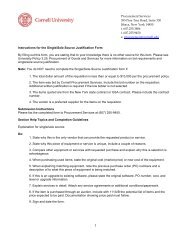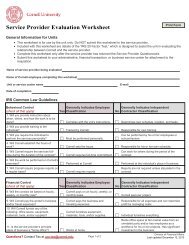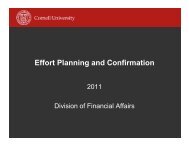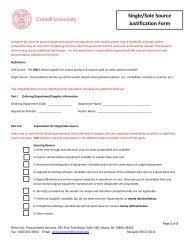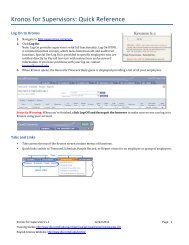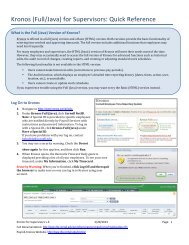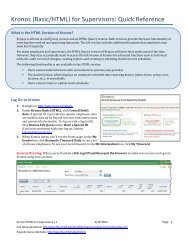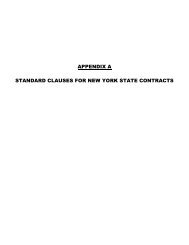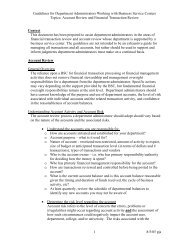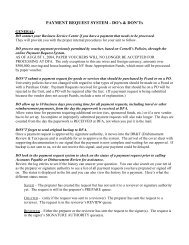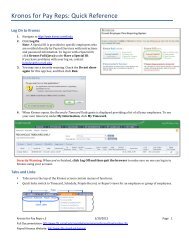Cornell University 2011-2012 Annual Report - DFA Home - Cornell ...
Cornell University 2011-2012 Annual Report - DFA Home - Cornell ...
Cornell University 2011-2012 Annual Report - DFA Home - Cornell ...
You also want an ePaper? Increase the reach of your titles
YUMPU automatically turns print PDFs into web optimized ePapers that Google loves.
NOTES TO CONSOLIDATED FINANCIAL STATEMENTS(dollars in thousands)F. Plan AssetsThe <strong>University</strong>’s overall investment objectives for the pension plan and postretirement medical benefit plan assets arebroadly defined to include an inflation-adjusted rate of return that seeks growth commensurate with a prudent level ofrisk. To achieve this objective, the <strong>University</strong> has established fully discretionary trusts with JP Morgan as trustee and investmentmanager for the Medical College’s defined benefit pension plan and the postretirement medical benefit plan for the<strong>University</strong>’s endowed employees on the Ithaca campus. Under those trust agreements, JP Morgan establishes investmentallocations and implements those allocations through various investment funds in order to carry out the investment objectives.JP Morgan has also been appointed as investment manager for the Medical College’s postretirement medical benefitplan with full discretion as to investment allocations in specific named funds managed by JP Morgan.The <strong>University</strong>’s Retirement Plan Oversight Committee (RPOC) provides guidance and oversight for the <strong>University</strong>’s retirementplans, including oversight of asset allocation and the performance of both the defined benefit pension plan andthe postretirement medical benefit plans. The committee engaged the services of an outside consulting firm to provideinformation to help that committee develop suggestions for strategies to better meet the overall objectives of growth coupledwith a prudent level of risk. These suggestions, regarding possible changes to the long-term strategic allocations, will bepresented to the trustee and investment manager. In fiscal year ending June 30, <strong>2012</strong>, the consulting firm was focused ongathering key information to inform its guidance in subsequent years.Risk mitigation is achieved by diversifying investments across multiple asset classes, investing in high quality securities andpermitting flexibility in the balance of investments in the recommended asset classes. Market risk is inherent in any portfoliobut the investment policies and strategies are designed to avoid concentration of risk in any one entity, industry, country orcommodity. The funds in which the plan assets are invested are well diversified and managed to avoid concentration of risk.The expected rate of return assumptions are based on information provided by external experts, including but not limitedto, investment managers at the trustee bank and the expertise within the <strong>University</strong>’s Investment Office. The factors thatimpact the expected rates of return for various asset types includes assumptions about inflation, historically based realreturns, anticipated value added by investment managers and expected average asset allocations. The expected returnon plan assets by category for the fiscal year ending June 30, <strong>2012</strong> are similar the prior fiscal year: 8.2 percent on equitysecurities, 3.9 percent on fixed income securities and 7 percent on real estate compared to 7.9 percent, 4.5 percent and 7percent, respectively.SUMMARY OF PLAN ASSETSTargetPension benefitsOther postretirementallocation <strong>2012</strong> <strong>2011</strong> <strong>2012</strong> <strong>2011</strong>Percentage of plan assetsEquity securities 39-85% 64.0% 66.0% 73.0% 72.0%Fixed income securities 15-55% 30.0% 30.0% 27.0% 28.0%Real estate 0-5% 6.0% 4.0% 0.0% 0.0%Total 100.0% 100.0% 100.0% 100.0%The relevant levels are based on the methodology for determining fair value: Level 1: valuation based on active marketsfor identical assets; Level 2: valuation based on significant observable inputs and Level 3: valuation based on unobservableinputs. Both the pension plan and postretirement medical benefit plans invest in funds to meet their investment objectives.The asset allocation is based on the underlying assets of the various funds. The leveling is based upon each fund asthe unit of measure.28



